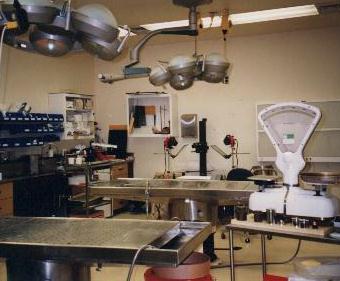thiruki@uniserve.com |
Board |
Anatomic Pathology
Welcome to the Morgue

Taceant colloquia. Effugiat risus.
(Let conversations cease. Let laughter depart.
Hic locus est ubi mors gaudet succurrere vitae.
This is the place where death delights to help the living.)
-- The Latin motto posted in the autopsy room of Dr. Milton Helpern,
the medical examiner of New York City in the 1960's
The morgue is the first thing people seem to think about when they hear the word
"pathology".
This probably isn't what you pictured: it's clean (thanks to Mount Sinai Hospital's morgue attendant Larry Q),
dry and well lit! Bodies that are to undergo post mortem examination are brought into the autopsy suite from the refrigerated storage room
(the "cadaver keep") and placed on the autopsy table.
The autopsy tables have built-in plumbing: irrigation hoses, suction tubes and drains.
Lights just like those used in operating rooms help the pathologists see into dark body cavities.
Also in the room are a lightbox for viewing X-rays, a scale for weighing organs, and a camera stand so interesting findings can be photographed.
In truth, autopsies represent a small and ever-shrinking part of a pathologist's workload these days
(except for forensic pathologists, who do them exclusively). The autopsy had its heyday in the pre-imaging era
(as late as the early 1980s in some places),
when nobody had any idea what was going on inside the bodies of sick people before they died.
Now, with fibre optic endoscopes and imaging techniques like ultrasound and CT, MR and PET scans it is possible to get an idea of the state of internal organs during life.
More important, sites of interest can be biopsied or surgically removed, so the disease process can be investigated
with pathology tools before it reaches the end stage.
The diagnostic assessment of such biopsies and surgical resections today represents
the bulk of a pathologist's work. Autopsies may tell us why a person died,
but it is the study of the early part of a disease process that helps us understand
its etiology (inciting agent) and pathophysiology (how the disease is caused),
and provides clues about potential treatments and cures.
Which is not to say that the autopsy is no longer of any value.
A post-mortem examination can be of use in the following situations:
Doctors are not perfect, and imaging techniques are not always accurate.
Even today, an autopsy will reveal a significant unsuspected diagnosis about 10% of the time (some studies place the frequency as high as 40%).
Autopsies can evaluate the effects of new diseases and new kinds of drug therapy, surgery and other interventions.
Guilt-ridden relatives may learn there was nothing more they could have done for the deceased.
Uncertainties that might otherwise lead to lawsuits can be resolved.
A recent development is the emergence of the private autopsy, a post-mortem examination
paid for by the family of the decedent, who want the results for a sense of closure or for litigation purposes.
Links
History of the Autopsy from Compton's Encyclopedia OnlineAutopsy Q & A American Association of Family Practioners handout
The Routine Autopsy A narrative guide for screenwriters and novelists
How to Perform an Autopsy Step-by-step text with an animated gif
Autopsy Tools What it takes
The Virtual Autopsy Try your hand as a post-mortem sleuth
Internet Autopsy Database Real case summaries galore
Pathological Examination of Pregnancies that Terminated in Spontaneous Miscarriages
These important studies are a kind of autopsy
How to Plan a Morgue Build the best!
Shandon Inc. Pittsburgh PA Suppliers of mortuary/autopsy equipment
Recent study finds autopsies still useful
The autopsy as a quality assurance tool: Last rites or resurrection?

Autopsies in the News Articles gathered by 1-800-AUTOPSY, a for-hire post mortem examination service
Autopsies FAQ Northwest Autopsy Service
"Postmortems on the kitchen table"
A look back at a time -- not so long ago -- when pathologists did autopsies during housecalls.
What Happens After Death? All about post-mortem changes
Coroner's Office, Kane County IL
Basic information about what a coroner does. Includes Coroner: An Historical Perspective
Thomas Noguchi: Coroner to the Stars An interview with the pathologist who performed Marilyn Monroe's autopsy
Very Post-Mortem Exams
Maryland's annual "historical clinicopathological conference" delves into the deaths of famous people of the past
Crime Scene Investigation Web Ring
Reddy's Forensic Home Page
You're On the Case
Fan site for the Discovery Channel series FBI Files and New Detectives
Autopsy HBO television series

CSI: Crime Scene Investigation CBS-TV's hit series
Forensic Files
About.com: Death and Dying Links to learning, support and professionals
Death, Dying, Funerals, Wills, Grief Title says it all
The Undertaking: Life Studies in the Dismal Trade
by Thomas Lynch, funeral director and author
Sooner or Later Devoted to the subject of death and dying
Mortician: Good listening and interviewing skills are vital
Young women a growing presence in the funeral service industry
University of Minnesota Program of Mortuary Science Get a Bachelor's degree
Last Words A collection of famous last words, epitaphs, obituaries, farewells and last stands
The Black Box Cockpit transcripts from planes that crashed
Darwin Awards Official Home Page People do the darndest things!
Bio-Clean Seattle-based "specialists in incident clean-up"
Urban Legends About Death Did this actually happen?
Top Ten Famous Last Words So you leave here with a smile :-)
| Questions? Suggestions? |
